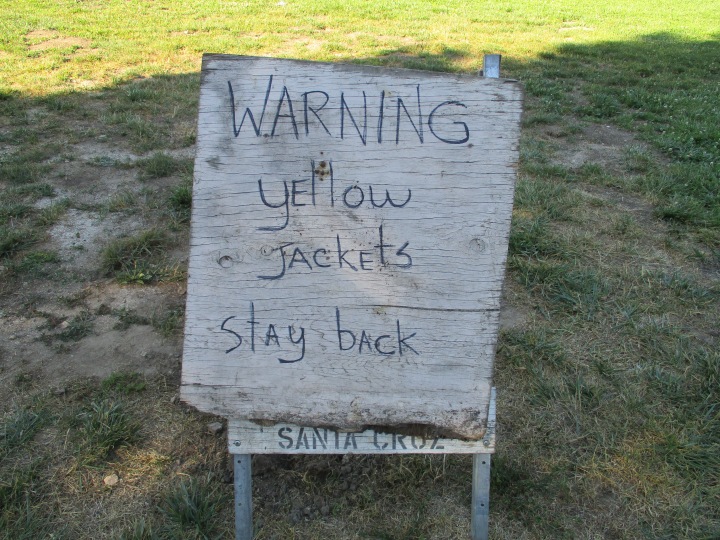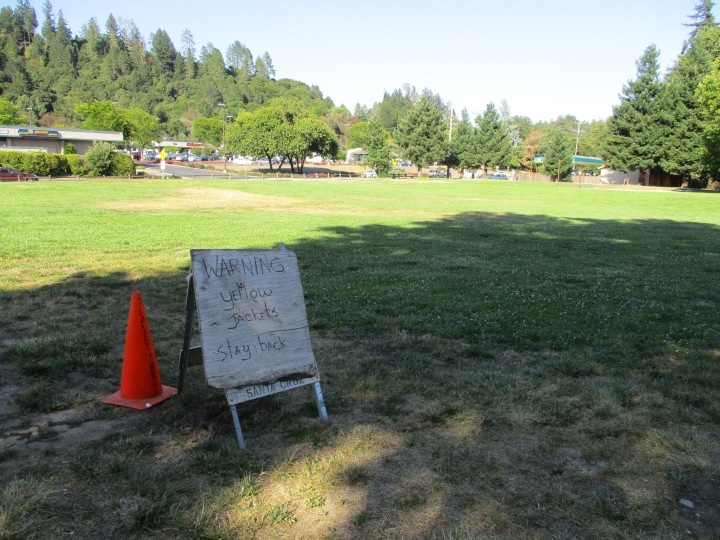 You would think that those who maintain the County Parks would be prepared for anything. They nearly are. They know how to deal with gophers, moles, voles, weeds, flooding, all sorts of unpleasant weather, and of course, spontaneous limb failure of massive trees. They apparently did not plan for this one.
You would think that those who maintain the County Parks would be prepared for anything. They nearly are. They know how to deal with gophers, moles, voles, weeds, flooding, all sorts of unpleasant weather, and of course, spontaneous limb failure of massive trees. They apparently did not plan for this one.
This improvisation with a bit of dirty old plywood and a felt marker certainly does not imply that they could not handle the situation. They merely lacked a sign to warn those in the Park to avoid the area where the now exterminated yellow jackets had started to build their subterranean hive. Some brave person already attacked the hive with a can of insecticide that can be sprayed from a distance, waited for returning yellow jackets to die, and finally dug the hive up. The sign is only there because of the possibility that some yellow jackets might return much later, and that those who could return may not die now that the excavation of the hive mixed soil with the insecticide.
This was NO simple task. Yellow jackets and wasps are NASTY! I found it necessary to exterminate a hive of wasps just last summer. Wasps do not pursue their assailants so aggressively, and the particular wasps that I exterminated were not so numerous. I am certain that it was considerably more risky for whomever sprayed and dug the hive that was below where this warning sign is now.
When yellow jackets and wasps are flying about and annoying people, but their hive can not be located, it is sometimes necessary to put out traps. These traps are particularly useful in trees that are infested with scale or aphid that excrete honeydew that attracts wasps and such. The instructions that come with the traps are rather amusing. They include a rather extensive list of the various species and varieties of wasps and yellow jackets, with pictures of their distinctive coloration and patterns, so that they can be identified. I do not want to get acquainted with them. I just want them DEAD!
- Comment
- Reblog
-
Subscribe
Subscribed
Already have a WordPress.com account? Log in now.
Nasty types of biodiversity those things – I used to be on call for wasp control as part of a wild-areas planting management program. I used a modified gas fire-extinguisher with 20 grams of carbaryl (nasty but quick) and a very long pressure line, oh and always check your running away route BEFORE you pull the trigger.
LikeLiked by 1 person
Gads! I have been very fortunate in that regard.
Although I hate to kill an entire hive, I would hate even more to let someone get stung. We just had a beehive removed, and will get two more removed (within the SAME building!) soon. They are so much easier to work with, and they will go to a good home in Watsonville. That big sycamore that I wrote about in regard to spontaneous limb failure has two hives in it, and one is now exposed by the limb failure.
LikeLike
Yep, bees are fine – I used to just call the beeman and he’d take them away in a cardboard box and to a new home, but we have lovely things here including Tasmanian paper wasps and german wasps.
LikeLiked by 1 person
The paper wasps who live here build big nests that look scary, but they seem to keep to themselves. If they are out of the way, we just pretend that we do not know they are there.
LikeLike
Ahh Tony, that image above is 6.9Mb – a bit slow even with a good link.
LikeLiked by 1 person
Really?! Should I use smaller pictures? Almost all of them are the same size. They are a bother for me to send, but I thought that my device was just too slow. I do not know how this sort of thing works.
LikeLike
Hi Tony, My wife uses https://imageresize.org/ for her blog https://exploringcolour.wordpress.com/ which is about, well, exploring colour. I use https://www.bricelam.net/ImageResizer/ a windows app. For a mac I don’t know.
LikeLiked by 1 person
I have not been editing my pictures at all. I adjust the size for one of the newspapers that wants my articles, but I make no other changes. Thank you for the information. If I determine a good size, I will probably just make all pictures fit, without doing any other editing.
LikeLike
I try to respect all stinging insects! We don’t have a lot of trouble with them around here, but I tend to stay clear if I see large numbers congregating. Fortunately, I don’t go hiking to the river much in the summer and fall months, but by winter, while on hikes, I see a lot of huge wasp paper nests in the trees or large bee hives that are inactive. No way I want to run into something like that!
LikeLiked by 1 person
The only bee hives in the Park are high up in a massive sycamore where there is no need to bother them. However, one was exposed recently when a massive limb tore away and fell from the tree. https://tonytomeo.com/2018/07/14/nature-is-messy/
We need to trap wasps at work because of they might bother guests. We recently had a beehive removed, and will need to get two more removed because they are ruining the building that they are in, and are too close to guests. Fortunately, they go to a good home in Watsonville.
LikeLiked by 1 person
Once years ago, the guy who mows for me came running around the side of the house, real fast. I asked him what was wrong. He had run close to a rabbit’s nest and at almost the same spot, over a yellow jacket’s hole in the ground. He said he had to run, cos “all of a sudden, there were rabbits and bees EVERYwhere!” The rabbits survived it, but the yellow jackets didn’t. I seldom resort to poisons, but their hole had to be sprayed.
LikeLiked by 1 person
Rabbits and bees! Oh my! Those are two things that do not often go together.
LikeLiked by 1 person
It was an interesting night. We put the rabbits back in their nest.
LikeLiked by 1 person
I didn’t know that bumblebees also will nest in the ground — until I learned it, to my chagrin. Who knew that one mad bumblebee could sting multiple times? I learned that, too.
LikeLiked by 2 people
While climbing a dead apple tree to cut it down, I got bit by a carpenter bee who nested in it. I had put my hand over the hole, and it wanted out. It was a polite bite, but it got my attention. The client liked the bees so much that she had us dismantle the carcass of the tree down almost as far as the nest, but then leave the trunk for another year. The trunk was not big enough to be a problem if it fell, so it was not problem.
LikeLike
I guess if they didn’t pull the stinger out of themselves. These were yellow jackets, who seem to have no goal except to be hateful.
LikeLiked by 1 person
That is it exactly. Their only goal in life is to be hateful! I never see them actually ‘doing’ anything constructive. Even if the pollinate something, they they are probably hateful about it.
LikeLiked by 1 person
While I would not want a wasp nest on my property, I have to give credit where credit is due. While tending to a tomato plant, a large tobacco hornworm caterpillar came tumbling down being attacked by a wasp. For the rest of the season with ever tomato I picked I had to give that little wasp a nod of thanks.
LikeLiked by 1 person
There are MANY different specie of wasps. Several are predatory to common garden pests. Others parasitize them. Every specie of fig, including the popular fruiting fig, relies on a specific specie of wasp for pollination. There are definitely many wasps who help out in the garden.
LikeLiked by 1 person
The paper wasps here also pretty much leave us alone unless you accidentally bump their nest! As I found out late last year. Ended up with eight painful stingers.
LikeLiked by 1 person
They are so big and bold that they should be easy to see and avoid.
LikeLiked by 1 person
These had built a nest under an ornament hanging from an eave on our outdoor decking area. I bumped into it whilst putting up a side wall. Perhaps our paper wasps are smaller than yours – still bloody painful though!
LikeLiked by 1 person
Some make small honeycomb like nests that are only two or three inches across. Those that we know as paper wasps make big round nests that look like silvery volleyballs.
LikeLiked by 1 person
Thanks, Tony, ours are like the honeycomb.
LikeLiked by 1 person
Reblogged this on Tony Tomeo and commented:
If this were not so terrifying, it would be funny.
LikeLike